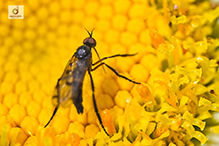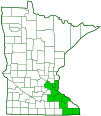dance fly
(Empis clausa)
Conservation • Description • Habitat • Ecology • Distribution • Taxonomy
|
|
||||||||||||||
Description |
Empis is a large genus of small dance flies. Numbers vary, but according to Catalogue of Life there are 976 Empis species worldwide. Empis clausa is a small dance fly. It occurs in the United States from the Upper Midwest to the southern Great Plains. Little is written about this or any other Empis species, Adults are about ⅛″ (4 mm) in length. The body is long and slender but relatively robust. The head is small and more or less spherical. The antennae have three segments. The third segment is rounded, it is not ringed, and it has a long terminal style. The compound eyes are large and dull orange. The mouthparts are extended into a long, rigid proboscis. There is a distinct, narrowed neck, visible from the side, connecting the head to the thorax. It allows for considerable head mobility. The thorax is black, large, and bulbous, making the fly appear hump backed. The legs are long and slender. On the female, the middle and hind legs have a feather-like fringe of long black hairs. The wings are clear with dark veins and dark banding along the cross veins. The radial sector vein (Rs) has only two branches (R4+5 is not forked). The radio-medial (r-m) cross vein is beyond the basal quarter of the wing. The anal cell is shorter than the second basal cell. The abdomen is long, tapered, and mostly black. There is a variable amount of orange on the ventral (underside) and sides of the first two abdominal segments, from slightly tinged to almost entirely orange. On the male, there is a conspicuous genital capsule under the abdomen. It is not folded forward. |
Size |
Total length: ⅛″ (4 mm) |
Similar Species |
Habitat |
|
Ecology |
Season |
|
Behavior |
Adults form mating swarms. The male will capture an insect and offer it as a gift to a potential mate. |
Life Cycle |
|
Larva Food |
|
Adult Food |
|
Distribution |
||
|
Sources |
|
| 7/28/2025 | ||
Occurrence |
||
|
||
Taxonomy |
|
Order |
|
Suborder |
Brachycera |
Infraorder |
Orthorrhapha |
Superfamily |
Empidoidea (dance flies, long-legged flies, and allies) |
Family |
Empididae (dance flies) |
Subfamily |
Empidinae |
Tribe |
Empidini |
Genus |
Empis |
Subgenus |
Coptophlebia |
Subordinate Taxa |
|
Synonyms |
|
|
|
Common Names |
|
This species has no common name. The common name for the family Empididae is dance flies, and it is applied here for convenience. |
|
Glossary
Proboscis
The tube-like protruding mouthpart(s) of a sucking insect.
Style
On plants: Part of the pistil, usually a slender stalk, connecting the ovary to the stigma(s). On flies (Diptera): A terminal, often slender or pointed, appendage arising from the end of the last, usually third, antennal segment.
Visitor Photos |
||
Share your photo of this insect. |
||
This button not working for you? |
||
Mike Poeppe |
 |
MinnesotaSeasons.com Photos |
||
|
||
|
||

Slideshows |
|

Visitor Videos |
||
Share your video of this insect. |
||
This button not working for you? |
||
|
Other Videos |
||
dance fly of some kind, maybe Empis clausa. |
About
Oct 31, 2021 I had a hard time keeping it in focus for some reason. |

|
Created: 7/28/2025 Last Updated: © MinnesotaSeasons.com. All rights reserved. |


